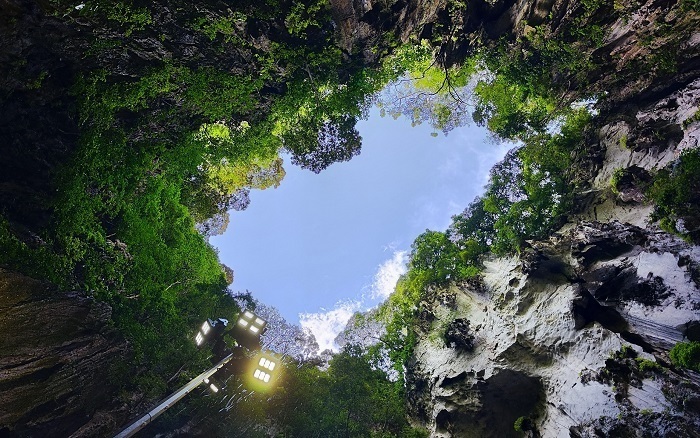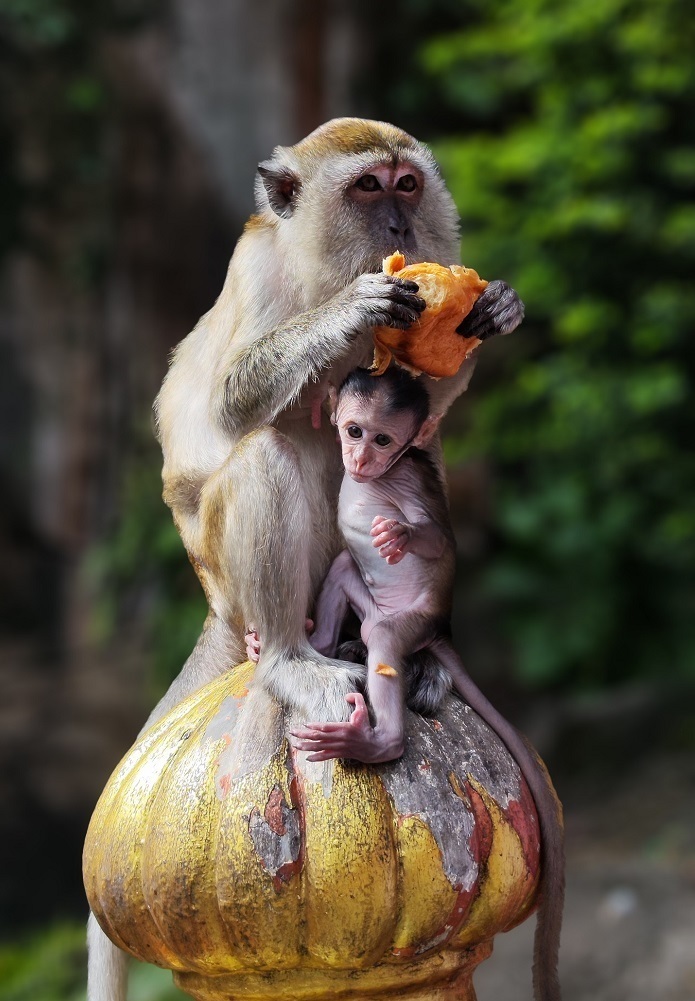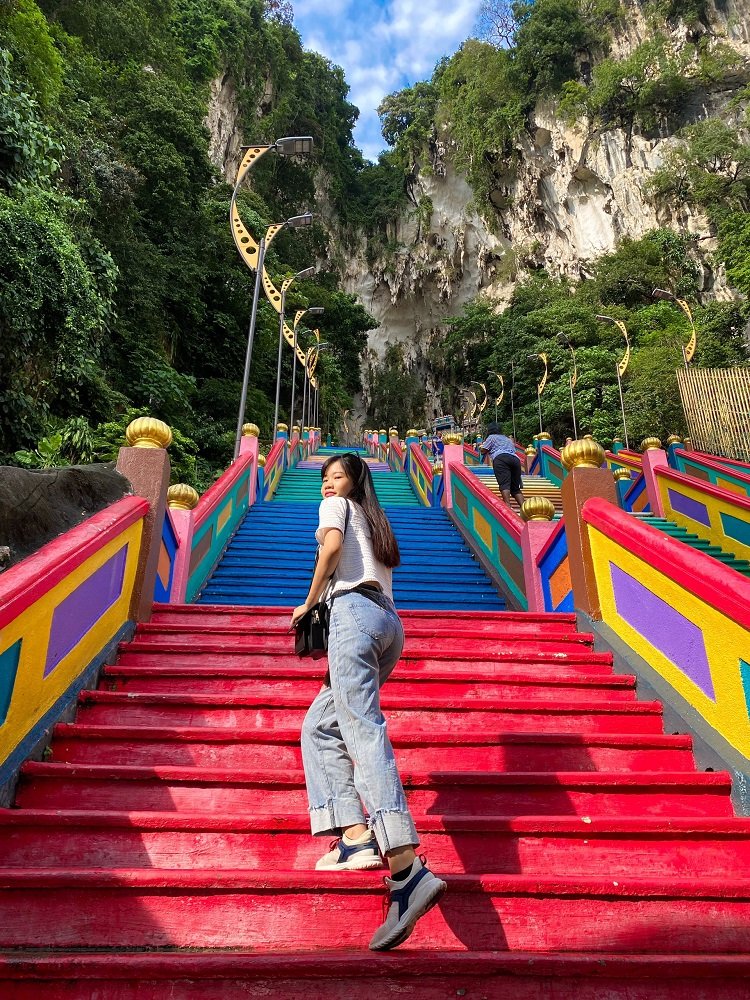DISCLOSURE: My articles may contain affiliate links. To click on those links, you won’t be charged any extra cost, instead, you help me to get some small commissions to maintain my blog. Thanks for understanding!
A giant golden Murugan Statue beside an Instagrammable colorful staircase – this is the most checked-in spot for tourists coming to Batu Caves.
I visited Batu Caves on my second visit to Malaysia. After covid lockdown, there are not many people visiting the caves, thus, it is a perfect time for me to discover the place without rushing.
In this blog post, I will share a complete guide to Batu Caves including its history, dress code, opening hours, interesting facts about Batu Caves, and more.
Read more:
Kuala Lumpur travel guide. Is it expensive in Kuala Lumpur?
Discover 25 things to do in KL at night
Table of Contents
1. About Batu caves
Where are the Batu Caves?
Batu Caves is a limestone mountain consisting of many caves. The caves are situated in Gombak, Selangor, Malaysia. It is 13 kilometers away to the north of the capital, Kuala Lumpur, and takes around 40 minutes to travel there by public transport.
Opening hours: Daily, 06:00 – 21:00
Ticket price
There are several attractions in Batu Caves, among which, the Temple Cave (on top of the colorful steps) is free of charge.
If you want to discover other caves, you need to pay for the entrance fee or a guided tour.
- Dark Cave: This cave is not always open to visitors. You can only visit the Dark Cave with a guided tour. There are 2 tour options: Educational tour and Adventure tour. The Educational tour costs 35RM/ adult, and 25RM/child, and lasts 45mins. The Adventure tour costs 80RM/adult, 55RM/child, and lasts up to 4 hours.
- Cave villa: It is nested at the foot of the main cave. The entrance fee is 15RM for foreigners and 7RM for local Malaysians.
- Ramayana Cave: The cave is situated to the left of the main cave, near the statue of Hanuman – the Monkey God. The entrance fee is only 5 RM.
Brief history
Batu Caves date back 400 million years ago. The earliest human presence in Batu Caves is said to be the indigenous Tamuan people, followed by the Chinese farmers who came here to exploit bat dung to fertilize their crops in the 1860s.
Not until the 1870s, did Batu Caves catch public attention after William Hornaday – an American naturalist – discovered the caves thanks to the locals during his elephant hunting party.
Inspired by the mouth of the cave which looks like the spear (vel) of Lord Murugan, K. Thamboosamy Pillay – an Indian trader – decided to build a Hindu temple inside the cave and made it a place of worship in 1888.
Read more: 15 Awesome places for a weekend getaway in Selangor
2. How to get to Batu Caves from KL?

By KTM
There is a direct KTM line from KL Sentral Station to Batu Caves Station. You can use your TnG card or buy single tickets at the ticket counter in front of the KTM entrance. One-way tickets cost 8RM, and tickets for the way back cost 5RM only.
From the Batu Caves train station, you just need to walk for 5-10 minutes to reach the caves.
Pro tips: You may want to download an app called MOVIT to see the exact timing of public transport in KL.
By Bus
From KL, you can also take bus No. 171 or No. 173 to reach Batu Caves. The journey takes around 50 minutes if you depart from KLCC.
However, buses in Kuala Lumpur are not very punctual and may get stuck in traffic jams.
(Detailed guide in FAQs section at the end of the post)
By Grab/ Taxi
You can download Grab app to book a ride to Batu Caves. The fare for a ride from KLCC to Batu Caves costs around 20 RM for a 4-seater car.
By tour
Here are the best tours that include Batu Caves in the itinerary:
- Kuala Lumpur Suburbs and Batu Caves Tour (from RM 40/pax)
- Genting Highlands and Batu Caves Day Tour from Kuala Lumpur (from RM 130/pax)
- Private Kuala Lumpur City Tour with Batu Caves and Fireflies Watching (from RM 487/pax)
PROMO: Click the links above and use this code DL6KGF to get RM 20 off
Rent a car
If you want to visit many other places in Kuala Lumpur, you can rent a car for convenience. If you go in a group, splitting the money is also quite cheap.
I provide car rental services in Malaysia at cheap prices, feel free to contact Whatsapp +60 149 776 712 or my Instagram. Follow me on Instagram to get 20RM off for your first booking.
4. Things to keep in mind when visiting Batu Caves
Dress code in Batu Caves
Here is the dress code in Batu Caves:
- Women: You should cover your shoulder and knees.
- Men: It’s fine to wear shorts or trousers.
If you don’t follow the dress code when visiting Batu Caves, the guards may not let you in. But don’t worry; they sell scarves for tourists to cover their lower parts. The price for a scarf is less than 1 USD.
Besides, if you want to enter the Hindu shrines, you must take off your shoes.
Pro tips: It’s advisable to wear comfortable shoes when visiting Batu Caves because you need to climb 272 steps to reach the Temple Cave.
The monkeys in Batu Caves

You are an animal lover? Come to Batu Caves where you can meet hundreds of wild long-tailed macaques. However, they are quite aggressive when stealing things from tourists such as food, water, towels, handbags, etc. anything caught by their eyes. So just be careful with your belongings, hold them tight when you visit Batu Caves.
Parking in Batu Caves
There is a huge parking area in Batu Caves. The parking fee is RM 2/car.
The best time to visit Batu Caves
Sure that it’s best to avoid rainy days when visiting Batu Caves. In Malaysia, the months with the most rainfall are September, October, March, and April.
If you cannot bear the heat, avoid the months of February, and March too.
The best time to visit Batu Caves would probably be December and January. Those are the coolest months in Malaysia with temperatures at around 25 Celcius degrees during the day.
My review of other attractions in KL:
4. Interesting facts about the Batu caves
Lord Murugan Statue – The 3rd tallest Hindu deity statue in the world

In front of the Temple Cave in Batu Caves is a giant golden Murugan statue 42.7 meters in height which took 3 years to construct. This is the tallest Hindu deity statue in Malaysia and the 3rd tallest in the world.
Murugan (also known as Kartikeya) is the Hindu God of War who is worshipped by Tamil communities in South India, Sri Lanka, Malaysia, etc.
He is the son of Parvathi and Shiva, whose life’s purpose is to eliminate Asuras and protect the Devas and other living beings.
The colorful Batu Caves steps risk the shrine being de-listed as the National Heritage Site

Originally, the Batu Caves staircase was made of wood. In 1940, the local authority replaced it with a concrete staircase with 272 steps.
In 2018, without approval from the National Heritage Department, the temple committee painted the staircase into an Instragrammable color range. Although this staircase helps to attract more tourists visiting the Batu Caves, it may put the Hindu shrine inside the Cave Temple in danger of being de-listed as a National Heritage Site.
Thaipusam Festival attracts thousands of devotees worldwide to Batu Caves
The Thaipusam Festival is held for more than 3 days in January or February every year. The festival celebrates the event when Parvati handed the spear (Vel) to Lord Murugan to defeat the evil demon Soorapadman, as well as Lord Murugan’s birthday.
During the Thaipusam Festival, thousands of devotees from India and Sri Lanka flood to Batu Caves to practice the ceremonial acts of devotional sacrifice through dance, food offerings, and bodily self-mortification. The festival starts in the morning (4 am) from Sri Mahamriamman Temple in Chinatown, then people head to Batu Caves and arrive by noon.
If you love to experience different cultures, plan your trip to Kuala Lumpur during Thaipusam Festival.
Batu Caves founder – K. Thamboosamy Pillay – also built the Sri Mahamariamman Temple in Chinatown.
K. Thambosamy Pillay was known as the leader of the Tamil community in Malaya in the 19th century and was a wealthy businessman in Kuala Lumpur at that time.
As a Hindu follower, K.Thambosamy Pillay founded 2 temples in Malaysia which are Sri Mahamariamman Temple and a Hindu temple inside Batu Caves in 1873 and 1888, respectively. Both are important Hindu temples among the Tamil community today which hold the Thaipusam festival yearly.
In addition, he was also one of the founders of Victoria Institution – the oldest secondary school in Kuala Lumpur.
You may also like: [Ultimate Guide] Best things to do in Malacca
5. Best hotels near Batu Caves
Here are some of the best accommodations located near Batu Caves which have review scores of at least 8/10:
The Concept Hotel KL – Batu Caves
- Price: from RM 57/night
- Rating: 8.2/10
- Distance from Batu Caves: 1.2 km
- Book now: Click here
A&R Urban Hotel
- Price: from RM 79/night
- Rating: 8.4/10
- Distance from Batu Caves: 4 km
- Book now: Click here
Suwara Hotel Kepong KL
- Price: from RM 67/night
- Rating: 8.7/10
- Distance from Batu Caves: 7.8 km
- Book now: Click here
Above is everything you need to know when visiting Batu Caves including its history, dress code, opening hours, interesting facts about Batu Caves, and more.
Any more questions? Feel free to comment below.
Thanks for reading!
Read more: A Complete Ipoh travel guide: transportation, interesting places in Ipoh, famous food, cost
1. How to get to Batu Caves from KL Sentral?
From KL Sentral, the most convenient way to reach Batu Caves is by KTM. The journey takes about 30 minutes. From the Batu Caves station, you just need to walk 10 minutes to the place.
2. What time is the last train from Batu Caves to KL Sentral?
The last train from Batu Caves to KL Sentral departs at about 10:10 PM from Batu Cave KTM Station. Make sure you arrive on time to not miss the last train of the day.
3. How long is the distance from Kuala Lumpur to Batu Caves?
Batu Caves is 13 km away from KL.
4. Is there any bus to Batu Caves from KL Sentral?
Yes, there is.
From KL Sentral, you can walk to Hab Medan Pasar (25 minutes) and take the bus 171 to Batu Industrial Park 5 (30 minutes). From there, you walk about 11 minutes to reach Batu Caves.
5. What time is the best time of day to visit Batu Caves?
Ideally, you visit Batu Caves before 10 AM and after 4 PM because that is when the temperature is not so high, making you trip much enjoyable.
6. What time is the Batu Caves temple’s closing time?
The Batu Caves close at 9 PM.
7. How to go from KLCC to Batu Caves?
From KLCC, you can take Bus 171 or Bus 173 to reach Batu Caves.
- Bus 171: Go to Bsn Lebuh Ampang Bus stop, get on the bus 171 and get off after 30 minutes at Batu Caves Industrial Park 5. From there, walk 11 minutes to Batu Caves.
- Bus 173: Also find Bsn Lebuh Ampang Bus stop, wait for bus 173 and go to Plaza Umo Batu Caves. Then walk 5 minutes to reach Batu Caves.
8. Can I visit Batu Caves at night?
Yes, you can. The closing time is 9 PM.
9. What is the Murugan Statue’s height in Batu Caves?
The Murugan Statue in Batu Caves has a height of 42.7 meters.
10. How many steps are there in the Batu Caves stairs?
There are 272 steps in the Batu Caves stairs.